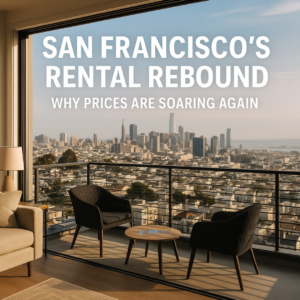San Francisco’s rental market is heating up at a pace not seen in years. After a period of sluggish growth during and right after the pandemic, rents across the city are rising sharply once more a clear signal that demand for urban living is surging back.
According to the latest report from Zumper, the average rent for a one-bedroom apartment in San Francisco has jumped 13% year over year, bringing it close to its pre-pandemic high. This puts the average rent at around $3,400 per month, with two-bedroom units up by 16.3%, approaching $4,500.
Neighborhoods Leading the Surge
The rise in prices isn’t evenly distributed. Some of San Francisco’s most desirable neighborhoods are seeing particularly steep increases:
-
Mission Bay – Rent for a one-bedroom has soared more than 21% over the past year. Once known as a quieter district, it’s now one of the city’s hottest rental zones thanks to its proximity to tech hubs and waterfront views.
-
Hayes Valley – Up 13.5%, reflecting its popularity among young professionals and those who want to live near restaurants, nightlife, and transit.
-
SoMa (South of Market) – Increased by 11.4%, continuing to attract tech workers and remote professionals seeking flexible hybrid work arrangements.
-
Civic Center – Jumped 10.9%, an indication that the downtown core is experiencing renewed activity.
-
South Beach – Up 9.3%, thanks to its luxury high-rises, waterfront access, and easy commuting options.
These neighborhood trends suggest not just rising costs, but also a shift in renter preferences back toward urban centers.
Why Rents Are Rising So Fast
Several key factors are driving this surge:
-
Return-to-Office Mandates
Major employers especially in tech are encouraging or requiring employees to return to the office several days a week. This has pushed renters who previously left the city during the pandemic to move back, intensifying competition for apartments. -
Tech and AI Boom
San Francisco is regaining its reputation as a tech epicenter. The city’s AI hiring surge has brought in new high-income renters, further increasing demand in premium neighborhoods. -
Urban Lifestyle Resurgence
After years of quieter streets, San Francisco is witnessing a cultural and social comeback. Foot traffic is increasing, local cafés and shops are bustling again, and there’s a growing sense of optimism that the city is “on its way back.” -
Limited Housing Supply
Even as demand grows, the pace of new housing construction remains slow. This imbalance between supply and demand continues to push rents upward. -
Short-Term Discount Era Ending
Many landlords offered lower rents during 2020–2022 to keep units filled. Those discounts are now expiring, and rents are snapping back to or surpassing pre-pandemic levels.
How SF Compares to Other U.S. Cities
San Francisco’s 13% rent increase is one of the fastest in the country. However, it’s not the most expensive rental market overall.
-
New York City still holds the top spot, with one-bedroom units averaging nearly $4,500 per month.
-
Los Angeles and Boston are also among the top tier.
-
By comparison, the national average rent for a one-bedroom apartment is about $1,520 less than half of what renters pay in San Francisco.
This stark difference highlights how regional demand dynamics and local job markets can heavily influence housing costs.
What This Means for Renters and Investors
For renters:
-
Expect more competition for apartments, especially in central neighborhoods.
-
Budgeting ahead and being ready to apply quickly will be key to securing a desirable unit.
-
Renters may want to consider neighborhoods just outside the hottest zones for better pricing.
For landlords and investors:
-
The strong rent growth reflects a rebounding market that could mean improved yields.
-
Downtown and transit-oriented areas may offer strong investment potential as demand climbs.
For the housing market overall:
-
The comeback is good news for economic recovery but raises concerns about housing affordability for lower- and middle-income residents.
-
If the supply gap isn’t addressed, rising rents could once again price out many longtime residents.
The Bigger Picture
San Francisco’s rental rebound is about more than just numbers. It reflects a shift in sentiment: people are once again choosing to live, work, and play in the city. With more foot traffic, business openings, and cultural events returning, the rental surge is a byproduct of a larger urban revival.
However, with rising rents also comes renewed urgency around housing affordability and policy solutions to ensure that the city remains accessible to a diverse range of residents.
Whether you’re a renter trying to navigate a competitive market or an investor eyeing opportunities, one thing is clear San Francisco’s rental landscape is on the move again.
Source: KTVU FOX 2 – San Francisco rent prices surge 13% since 2024

